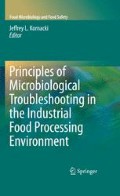Abstract
This chapter stems from personal experiences assisting companies after plant or line shuts down in response to contamination events and FDA- or USDA-associated recalls. Questions addressed include “How does one know that the problem has been eliminated?” “When am I allowed to start up?” “Should I hold the product and test and, if so, for how long?” “What unique activities are helpful on the first (and subsequent) day(s) of start-up to ensure a contamination-free product?” Gaining confidence that one can start up a previously shutdown line will come from thorough review and validation or revalidation of a variety of programs including the Hazard Analysis Critical Control Points (HACCPs) plan, ingredient specifications, sanitation standard operating procedures (SSOPs), and good manufacturing practices (GMPs). In addition, finding and eliminating microbial growth niches for the pathogen of concern, especially those associated with product contact or near product contact surfaces, will provide some assurance of safety.
Access this chapter
Tax calculation will be finalised at checkout
Purchases are for personal use only
References
Annous BA, Kozempel MF (1998) Influence of growth medium on thermal resistance of Pediococcus spp. NRRL B-2354 (formerly Micrococcus freudenreichii) in liquid food. J Food Prot 61:578–581
Annous BA, Kozempel MF, Kurantz MJ (1999) Changes in membrane fatty acid composition of Pediococcus sp. strain NRRL B2354 in response to growth conditions and its effect on thermal resistance. Appl Environ Microbiol 65:2857–2862
Eblen DR, Annous BA, Sapers GM (2005) Studies to select appropriate nonpathogenic surrogate Escherichia coli strains for potential use in place of Escherichia coli O157:H7 and Salmonella in pilot plant studies. J Food Prot 68:282–291
Engeljohn D (2004) Regulatory Perspective of Validation and Verification Activities. Presented in symposium S03, Validation and verification of pathogen interactions in meat and poultry processing, International Association for Food Protection Annual Meeting, Phoenix, 8–11 August 2004
Evans JR, Lindsay WM (1996) Fundamentals of statistical process control, Chapter 15. In: Evans JR, Lindsay WM (eds) The Management and Control of Quality, 3rd edn. West Publishing Company, New York, pp. 639–698
FDA (2000) Kinetics of microbial inactivation for alternative food processing technologies. http://vm.cfsan.fda.gov/∼comm/ift-toc.html. Accessed 25 July 2008
ICMSF (1988) HACCP in microbiological safety and quality. In: Silliker JH, Baird-Parker AC, Bryan FL, Christian JHB, Roberts TA, Tompkin RB (eds) Microorganisms in Foods, Volume 4. Blackwell Scientific Publications, Boston
Ma L, Kornacki JL, Zhang G, Lin CM, Doyle MP (2007) Development of thermal surrogate microorganisms in ground beef for in-plant critical control point validation studies. J Food Prot 70(4):952–957
Marth EH (1979) Food safety: Can it be achieved. Presented at the Spring Meeting of the Central States Association of Food and Drug Officials, Madison, WI, April 25, 1979. Reprinted from the Quarterly Bulletin of the Association of Food and Drug Officials, Volume 44(1) January, 1980, ISSN:0195-4865, pp. 12–21.
Mortimore S, Wallace C (1998) HACCP: A Practical Approach, 2nd edn. Aspen Publishers, Gaithersburg, MD
NACMCF (1997) Hazard analysis and critical control point principles and application guidelines: Adopted August 14th, 1997. http://vm.cfsan.fda.gov/∼comm/nacmcfp.html. Accessed 25 July 2008
National Research Council (1985) An Evaluation of the Role of Microbiological Criteria for Foods and Ingredients. National Academic Press, Washington, DC
Sperber WH (1999) Thoughts on today’s food safety…The role of validation in HACCP plans. Dairy, Food Environ Sanit 19(12):920
Author information
Authors and Affiliations
Corresponding author
Editor information
Editors and Affiliations
Rights and permissions
Copyright information
© 2010 Springer Science+Business Media, LLC
About this chapter
Cite this chapter
Kornacki, J.L. (2010). When Can I Start Up My Factory or Processing Line Again?. In: Kornacki, J. (eds) Principles of Microbiological Troubleshooting in the Industrial Food Processing Environment. Food Microbiology and Food Safety. Springer, New York, NY. https://doi.org/10.1007/978-1-4419-5518-0_9
Download citation
DOI: https://doi.org/10.1007/978-1-4419-5518-0_9
Published:
Publisher Name: Springer, New York, NY
Print ISBN: 978-1-4419-5517-3
Online ISBN: 978-1-4419-5518-0
eBook Packages: Chemistry and Materials ScienceChemistry and Material Science (R0)

